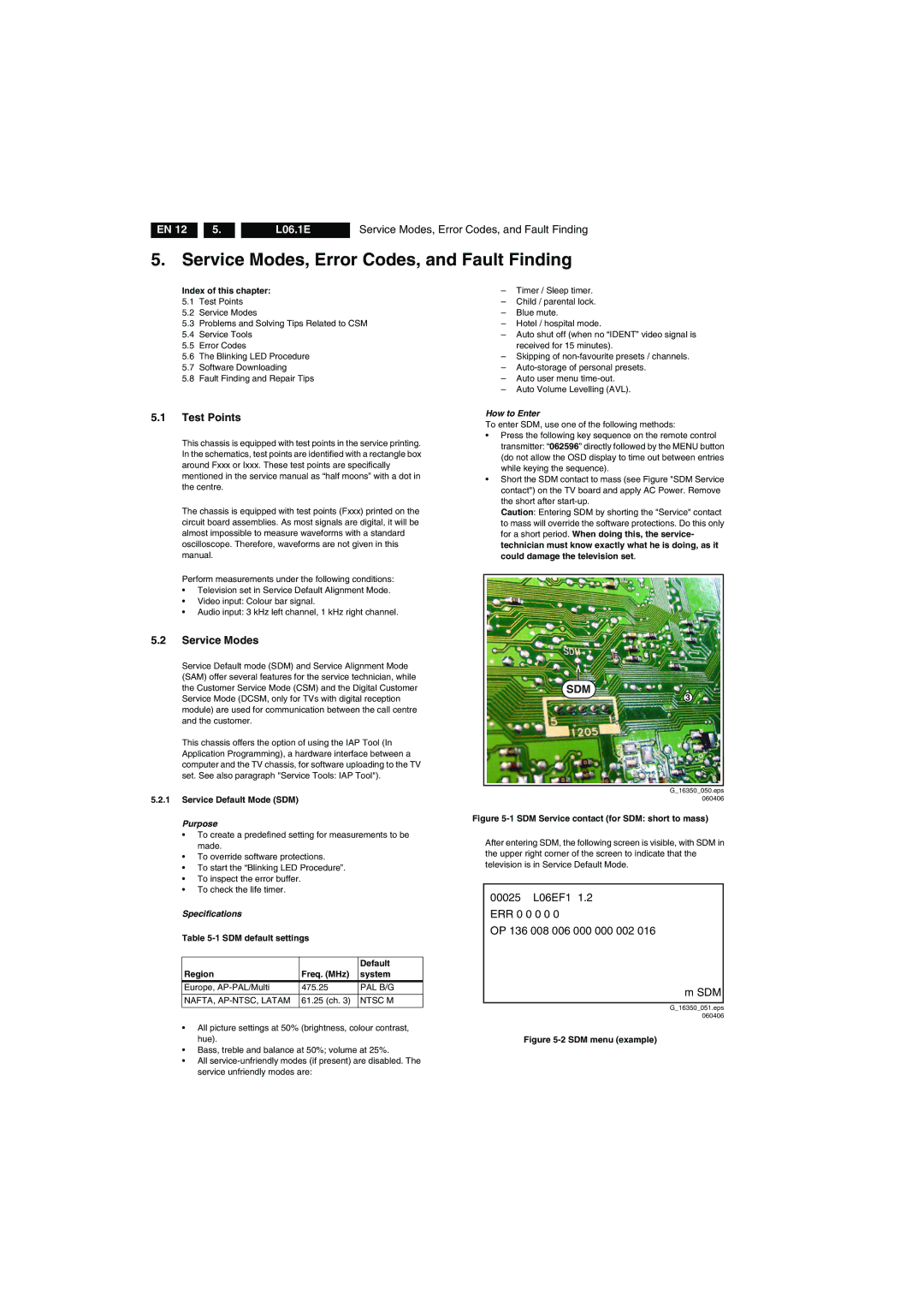
EN 12 |
| 5. |
| L06.1E | Service Modes, Error Codes, and Fault Finding |
5. Service Modes, Error Codes, and Fault Finding
Index of this chapter:
5.1Test Points
5.2Service Modes
5.3Problems and Solving Tips Related to CSM
5.4Service Tools
5.5Error Codes
5.6The Blinking LED Procedure
5.7Software Downloading
5.8Fault Finding and Repair Tips
5.1Test Points
This chassis is equipped with test points in the service printing. In the schematics, test points are identified with a rectangle box around Fxxx or Ixxx. These test points are specifically mentioned in the service manual as “half moons” with a dot in the centre.
The chassis is equipped with test points (Fxxx) printed on the circuit board assemblies. As most signals are digital, it will be almost impossible to measure waveforms with a standard oscilloscope. Therefore, waveforms are not given in this manual.
Perform measurements under the following conditions:
•Television set in Service Default Alignment Mode.
•Video input: Colour bar signal.
•Audio input: 3 kHz left channel, 1 kHz right channel.
5.2Service Modes
Service Default mode (SDM) and Service Alignment Mode (SAM) offer several features for the service technician, while the Customer Service Mode (CSM) and the Digital Customer Service Mode (DCSM, only for TVs with digital reception module) are used for communication between the call centre and the customer.
This chassis offers the option of using the IAP Tool (In Application Programming), a hardware interface between a computer and the TV chassis, for software uploading to the TV set. See also paragraph "Service Tools: IAP Tool").
5.2.1Service Default Mode (SDM)
Purpose
•To create a predefined setting for measurements to be made.
•To override software protections.
•To start the “Blinking LED Procedure”.
•To inspect the error buffer.
•To check the life timer.
Specifications
Table 5-1 SDM default settings
|
| Default |
Region | Freq. (MHz) | system |
Europe, | 475.25 | PAL B/G |
|
|
|
NAFTA, | 61.25 (ch. 3) | NTSC M |
|
|
|
•All picture settings at 50% (brightness, colour contrast, hue).
•Bass, treble and balance at 50%; volume at 25%.
•All
–Timer / Sleep timer.
–Child / parental lock.
–Blue mute.
–Hotel / hospital mode.
–Auto shut off (when no “IDENT” video signal is received for 15 minutes).
–Skipping of
–
–Auto user menu
–Auto Volume Levelling (AVL).
How to Enter
To enter SDM, use one of the following methods:
•Press the following key sequence on the remote control transmitter: “062596” directly followed by the MENU button (do not allow the OSD display to time out between entries while keying the sequence).
•Short the SDM contact to mass (see Figure "SDM Service contact") on the TV board and apply AC Power. Remove the short after
Caution: Entering SDM by shorting the "Service" contact to mass will override the software protections. Do this only for a short period. When doing this, the service- technician must know exactly what he is doing, as it could damage the television set.
SDM
3
G_16350_050.eps 060406
Figure 5-1 SDM Service contact (for SDM: short to mass)
After entering SDM, the following screen is visible, with SDM in the upper right corner of the screen to indicate that the television is in Service Default Mode.
00025 L06EF1 1.2
ERR 0 0 0 0 0
OP 136 008 006 000 000 002 016
m SDM
G_16350_051.eps 060406
